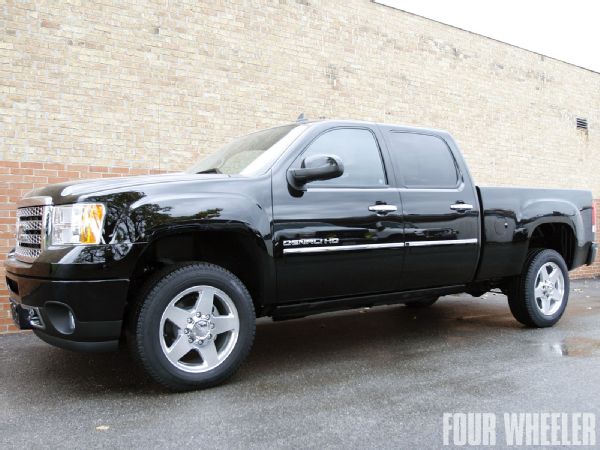
 Ken Brubaker
Senior Editor, Four Wheeler
Ken Brubaker
Senior Editor, Four Wheeler
The 2011 GM 2500HD pickups are a vastly different animal compared to the 2010 models. A casual glance at the exterior won't tell you much, but take a gander underneath and the changes will leave you mesmerized. The frames are all-new, and the front frame structure is 125 percent stiffer. The front suspension is still an independent torsion-bar setup, but it's completely redesigned with forged steel upper control arms and machined cast-iron lower control arms. The steering is also redesigned with a new larger steering gear, linkages, and new power steering pumps for both gas and diesel applications. Out back, the truck uses a new, larger asymmetrical leaf-spring design. The leaves are three inches wide, which is an increase of 20 percent. When combined with the enhanced powertrain systems, the 2500HD pickups boast greater towing and payload capacity as well as improved ride and handling characteristics.
 Before
Before
BDS Suspension, hailing from Coldwater, Michigan, was the first aftermarket manufacturer to get a kit for this vehicle to market. Their High Clearance kit lifts the truck 6 1/2 inches and allows fitment of up to 37x12.50 tires. The kit features some unique items like torsion bar mounts that integrate with the lower A-arms. This system eliminates the need for lowering the torsion bars. The kit also includes ductile iron CNC-machined steering knuckles that are made in the U.S.; differential and front impact skidplates that protect and also lock the new crossmembers together for strength; and new stainless-steel front brake lines.
We recently spent a day at Attitude Performance in Arlington Heights, Illinois, watching owner Matt Dinelli install one of the first kits under a customer's brand spankin' new rig. It was fascinating to see how BDS approached lifting the new 2500HD. Here are some highlights of the install.
Bottom Line
We really like the fact that this kit focuses on high-clearance componentry, and when you gaze underneath the rig, there's nothing dangling or protruding. This is due in part to the A-arm-mounted torsion bar brackets and the high-arched crossmembers. Installation of the kit was as expected, and was nothing out of the ordinary for an IFS rig. Ride and handling are reported to be outstanding, and there are no weird squeaks or rattles coming from the underside.
The owner of this rig chose to replace the factory LT265/60R20 (32.5-inch-diameter) Goodyear Wrangler SR-A tires with 35x12.50-20 Nitto Trail Grappler tires on 20x9-inch KMC Addict wheels. (It's also worth noting that the 2011 2500HD uses an 8x180mm bolt pattern, which is different than its predecessor) This combination improved the front valance-to-ground measurement from 10.5 inches to 18.25 inches (a 74-percent increase) and the rear hitch-to-ground measurement from 18 inches to 24 inches (a 33-percent increase). Approach angle jumped from 22.3 degrees to 38.7 degrees (a 74-percent increase).
Overall, we were pleased with the outcome of this install. Not only will the truck perform better off-highway, it looks far more balanced with the increase in altitude and larger tires.
PhotosView Slideshow



















